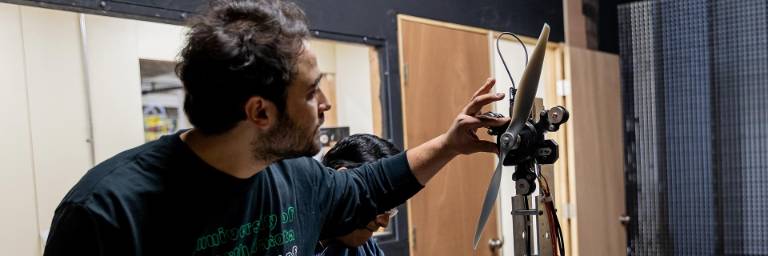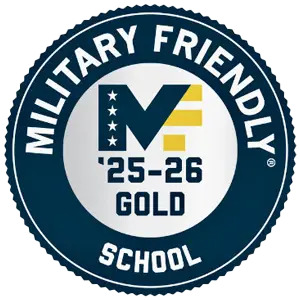Aerospace Engineering Degree
Study at the only aerospace engineering program in North Dakota, South Dakota, Montana and Idaho.
Gain access to aerospace companies to launch your career as an aerospace engineer. You'll be at the forefront of modern technology with this bachelor's degree in Aerospace Engineering.
- Program type:
- Major
- Format:
- On Campus or Online
- Est. time to complete:
- 4-5 years
- Credit hours:
- 128
Why earn an Aerospace Engineering bachelor's degree?
Aerospace Engineering Degree Online or On-Campus
-
Thrive in hands-on classes, learning about the latest technologies used in the design and construction of aircraft and spacecraft.
-
Find your flock in one of our 20+ engineering student organizations, including the Advanced Rocketry Club, who designs, builds, launches, and competes with their own rockets at the national level.
-
Participate in extracurricular experiences through variety of projects. You'll learn leadership, communication, teamwork and lifelong skills necessary for success in a diverse global marketplace.
-
Use professional engineering software for CAD, CFD, and FEA to perform engineering design and analysis.
-
Learn in manufacturing labs to fabricate and build components for aerospace systems, such as airframes, UAVs, robots, and rockets.
-
Work with faculty on world-renowned research projects.
What skills can you learn from an Aerospace Engineering degree?
Empowered by experiential education and hands-on learning, you’ll get your hands dirty learning in-demand topics.
✓ Aerodynamics & Aeromechanics
✓ Aerospace Propulsion
✓ Aerospace Structures
✓ Compressible Fluid Flow
✓ Computational Fluid Dynamics
✓ Engineering Design
✓ Flight Dynamics & Control
✓ Fluid Mechanics
✓ Hypersonics
✓ Mechanics of Flight
✓ Orbital Mechanics
✓ Rocketry
✓ Satellite Development
✓ Thermodynamics
✓ UAVs
-
What can you do with an Aerospace Engineering degree?Aerospace Engineering Degree Courses
Online Aerospace Engineering Degree
What to expect with UND's Aerospace engineering online degree?
Over a third of UND's student population is exclusively online; plus, more take a
combination of online and on-campus classes. You can feel reassured knowing you won't
be alone in your online learning journey, and you'll have resources and services tailored
to your needs.
No matter how you customize your online experience, you’ll get the same top-quality
education as any other on campus student.
- Same degree: All online programs are fully accredited by the Higher Learning Commission (HLC). Your transcript and diploma are exactly the same as our on-campus students.
- Same classes: You’ll take courses from UND professors, start and end the semesters at the same time and take the same classes as a student on campus.
- Real interaction: You can ask questions, get feedback and regularly connect with your professors, peers and professionals in the field.
- Your own academic advisor: As an invaluable go-to, they’re focused on you, your personal success and your future career.
- Free online tutoring: We're here to help you one-on-one at no cost. Plus, get access to a variety of self-help online study resources.
- Unlimited academic coaching: Need support to achieve your academic goals or feeling stumped by a tough course? We'll help with everything from stress and time management to improving your memory to achieve higher test scores.
- Full online access: Dig into virtual research at UND's libraries. Improve your writing skills with online help from the UND Writing Center. Get online access to career services, veteran and military services, financial services and more.
- 24/7 technical support: UND provides free computer, email and other technical support for all online students.
- Networking opportunities: Our significant online student population means you’ll have a large pool of peers to connect with. UND has numerous online events and activities to keep you connected.
Best Online College
Our high alumni salaries and job placement rates, with affordable online tuition rates make UND a best-value university for online education. UND's breadth of online programs rivals all other nonprofit universities in the Upper Midwest making UND one of the best online schools in the region.
UND ranks among the best online colleges in the nation for:
- Affordability
- Student satisfaction (retention rate)
- Academic quality (4-year graduate rate)
- Student outcomes (20-year return on investment per Payscale.com)
Military Friendly® School
FAQs
Yes, aerospace engineering is in high demand. Employment of aerospace engineers is projected to grow 6% from 2022 to 2032, which is faster than the average for all occupations. Approximately 3,800 openings are projected each year.
Compare our online and on campus costs. You'll find we are one of the most affordable aerospace engineering colleges in the Midwest. Our online students pay the same affordable tuition rate regardless of their legal residency.
UND is committed to assisting students in funding their education, providing over $105 million in financial aid annually. A range of financial aid options offered by UND, including scholarships (merit-based), grants (need-based), and loans, help students alleviate college costs.
An Aerospace Engineering degree can be challenging, but it's a journey that varies for each student. With a strong commitment and persistent effort, the complexities and rigorous aspects of the program can be successfully managed and mastered. Successful students should be good at math and science, as well as be motivated to solve complex problems.
Yes, UND offers an online Aerospace Engineering degree. While most courses are offered online, students do need to come to campus for condensed summer labs for a few portions of the program, allowing them to extend and apply their knowledge through hands-on activities.
Leaders in Engineering
Helping you fulfill your aspirations is our highest priority. We'll work with you to design a custom educational plan that meets your goals.

